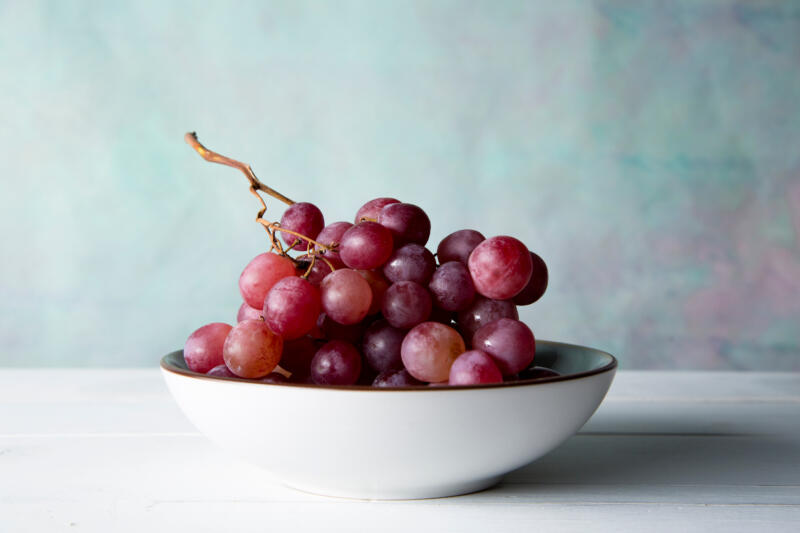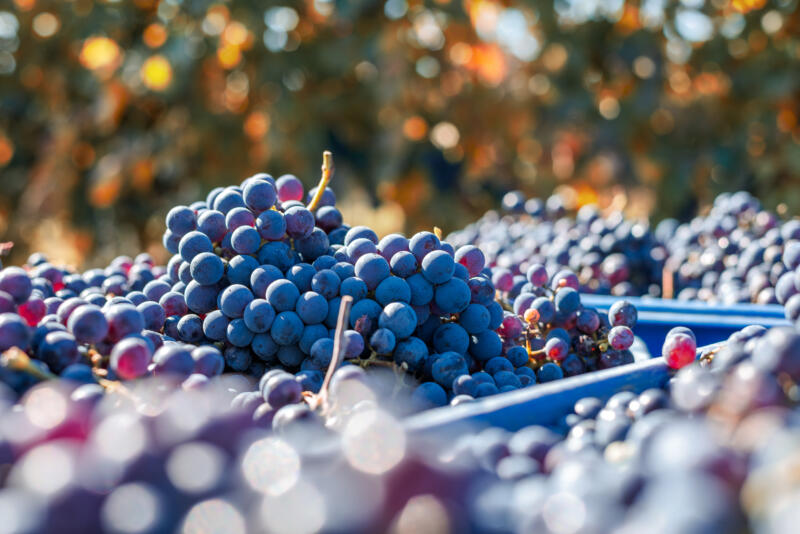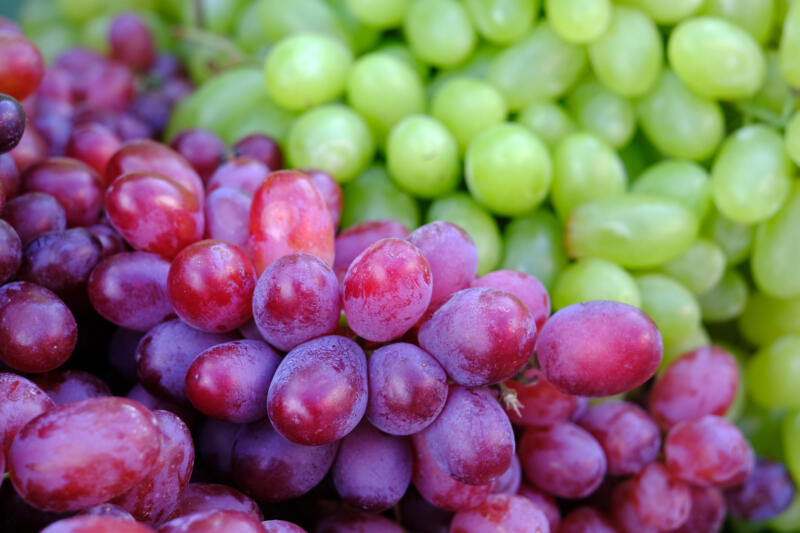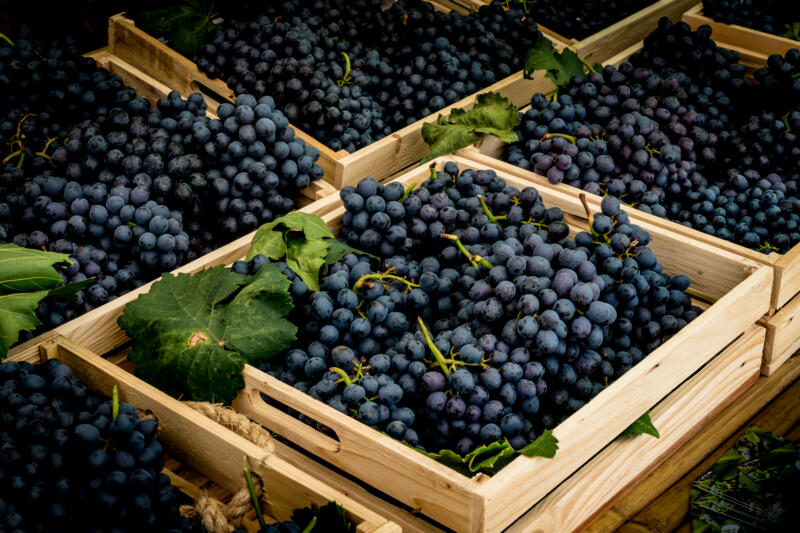Understanding the acidity of grapes is not just a matter of culinary curiosity, but it also has significant implications for our health.

The acidity of grapes, like any other fruit, can influence how they interact with our bodies. It can affect everything from our digestive system to our oral health.
So, let’s dive into the world of grapes and explore their acidity.
In this article:
Understanding Acidity in Fruits

When we talk about acidity in fruits, we’re referring to the presence of certain types of organic acids.
These acids contribute to the fruit’s overall taste, often providing a tangy or tart flavor that balances out the sweetness.
The acidity in fruits adds depth and complexity to their taste, enhancing our culinary experiences.
It’s important to note that some fruits are naturally sweeter or more acidic than others due to their inherent characteristics.
For instance, citrus fruits like lemons and oranges are well-known for their high acidity, which can be attributed to their substantial citric acid content.
Conversely, fruits like bananas and melons are generally lower in acidity, making them a sweeter option.
Fruits’ Maturity
As fruits ripen, their acidity typically decreases. This is because the acids in the fruit are converted into sugars, leading to a sweeter taste.
Therefore, a ripe fruit will generally be less acidic and sweeter than the same fruit when it’s unripe.
Variety
Even within the same type of fruit, different varieties can have vastly different levels of acidity.
For example, Granny Smith apples are known for their tart, acidic flavor, while Fuji apples are much sweeter and less acidic.
Similarly, among grapes, Sauvignon Blanc and Pinot Noir varieties are known for their high acidity, while Chardonnay and Merlot grapes are typically less acidic.
Growing Conditions
The acidity of fruits is also significantly influenced by where they are grown.
Fruits grown in warmer climates tend to be less acidic than those grown in cooler climates, as the warm weather accelerates the ripening process, leading to a quicker conversion of acids into sugars.
Acidity in Grapes and Its Impact on Health
Grapes, like all fruits, contain organic acids. Grapes mainly contain tartaric acid and malic acid, with citric acid present in smaller quantities.
These acids play a crucial role in defining the grape’s flavor profile, contributing to their characteristic tartness that balances the fruit’s inherent sweetness.
But the acidity in grapes isn’t just about flavor. It also has implications for health.
For instance, people with conditions like gastroesophageal reflux disease (GERD) often need to monitor their intake of acidic foods, and grapes might be a consideration in this context.
On the other hand, the organic acids in grapes can also have benefits, such as helping to regulate blood pressure.
Types of Grapes and Their Acidity Levels
Wine Grapes

Wine grapes, which include a vast array of varieties, have varying acidity levels.
Here are some grape varieties that are known for producing acidic wines:
- Riesling: This grape variety is known for its high acidity and is used to produce a variety of wine styles from dry to sweet.
- Sauvignon Blanc: This grape variety is also known for its high acidity. It is often used to produce dry, crisp wines with citrus and green fruit flavors.
- Chenin Blanc: This grape variety can produce high-acidity wines, especially when grown in cooler climates.
- Chardonnay (especially from cooler climates): While Chardonnay can vary in acidity depending on where it is grown, those from cooler climates tend to have higher acidity.
- Pinot Noir: This red grape variety is known for its high acidity. It is used to produce light to medium-bodied wines with red fruit flavors.
- Sangiovese: This Italian red grape variety is also known for its high acidity. It is used to produce a variety of wine styles, including Chianti.
- Nebbiolo: An Italian red grape type recognized for its pronounced acidity. It’s the primary grape in crafting Barolo and Barbaresco wines.
- Barbera: This red grape variety from Italy is known for its bright acidity and is often used to produce juicy, fruity wines.
- Albariño: A white grape from Spain, it’s celebrated for its pronounced acidity and is commonly crafted into fragrant, sharp wines.
- Tempranillo: This Spanish red grape variety can produce wines with high acidity, especially when grown in cooler regions of Spain.
It is important to note while it’s a common assumption to associate the color of the grape with its acidity, this is not always accurate.
The acidity of a grape is more closely tied to its specific variety and maturity rather than its color.
For example, both high and low acidity grapes can be found among both green (white) and red (black) varieties. Therefore, using color as a sole indicator of a grape’s acidity can potentially lead to misconceptions.
Table Grapes

In addition to wine grapes, table grapes, which are primarily grown for fresh consumption, also exhibit a wide range of acidity levels.
The acidity of a grape can vary based on many factors:
- the specific variety of grapes,
- the climate and soil in which it was grown,
- the point at which it was harvested.
Generally, both white and black table grapes can range from very sweet to more tart or acidic.
Here is the list from most acidic to the sweetest suitable for fresh consumption:
- Concord: Known for their high acidity level, often used for grape juice, jelly, and grape-flavored soft drinks. They are also eaten fresh.
- Black Corinth (Zante currant): Produces small, seedless black grapes with a high acidity level.
- Red Globe: Produces very large, seeded grapes with a thick, red skin and a high level of acidity.
- Flame Seedless: A vigorous, heavy-bearing table grape variety that produces large clusters of medium-sized, round, red grapes. They have a nice balance of sweetness and acidity.
- Thompson Seedless (Sultanina): One of the most popular table grapes, it has a good balance of sweetness and acidity.
- Crimson Seedless: Produces large, elongated, light red grapes. They have a sweet-tart flavor with a hint of spiciness, leaning more towards the sweet side.
Derivative Products: Grape Juice, Jam, Jelly and Wine

When grapes are transformed into derivative products like wine, juice, jam, or jelly, their acidity levels can change.
The process of fermentation used in winemaking, for example, can alter the grape’s original acidity.
White wines, which are often made from high-acid grapes, tend to retain more of their acidity compared to red wines.
Grape juice, jam, and jelly, on the other hand, often have added sugars, which can balance out the grape’s natural acidity, making these products taste less acidic.
It’s important to note that while moderate consumption of these grape-derived products can be part of a healthy diet, their acidity can impact individuals with certain health conditions, such as acid reflux or sensitive teeth.
Grapes and Acid Reflux
For individuals with acid reflux, the acidity in grapes can be a concern.
Acid reflux, often referred to as gastroesophageal reflux disease (GERD), occurs when stomach acid consistently backs up into the esophagus, resulting in discomfort and potential injury to the esophageal lining.
While grapes are not as acidic as citrus fruits, their acidity can still trigger symptoms in some individuals with GERD.
If you have acid reflux, it’s advisable to monitor your symptoms and see how you react to different types of grapes. You might find that ripe, red grapes are more tolerable than tart, green grapes.
As always, if you have any concerns about your diet and how it relates to your health, it’s best to consult with a healthcare professional.
Grapes in Diet: Balancing Acidity for Bone Health and a Balanced Diet
Maintaining a balanced diet is not just about counting calories or limiting sugar intake.
It’s also about balancing the acidity and alkalinity of the foods we consume.
This balance is particularly important for bone health, as a diet high in acidic foods can lead to a decrease in bone density.
Grapes, while slightly acidic, can be balanced in your diet with alkaline foods like leafy green vegetables, cucumbers, and celery.
Pairing grapes with cheese, a food that is alkaline, is not just a classic culinary combination but also a way to balance acidity.
Beyond their acidity, grapes are a valuable addition to our diets.
They provide essential nutrients like vitamin K and vitamin C, along with a good amount of water, making them a hydrating snack.
Moreover, grapes are rich in polyphenolic compounds, including resveratrol and flavonoids, which are potent antioxidants.
These compounds have been linked to numerous health benefits, including heart health, anti-aging, and potentially even anti-cancer effects.
Grapes also contain small amounts of protein and fiber, contributing to a balanced diet.
Closing Thoughts
For those with a healthy digestive system, consuming grapes should pose no issues.
Their slight acidity is well-tolerated, and their nutrient content makes them a beneficial addition to your diet. Enjoy their unique sweet-tart flavor and reap the health benefits they offer.
However, for individuals with digestive issues, caution is advised. While grapes are nutritious, their acidity could potentially cause discomfort, especially if consumed in large amounts.
If you have a sensitive stomach or a digestive condition, it’s important to monitor your reaction to grapes and consume them in moderation.
Pairing them with alkaline foods can also help balance their acidity.
Do you have a favorite variety?
Have you noticed any effects from their acidity?
Share your stories in the comments below!
Red grapes are irritating my mouth. Very painful!